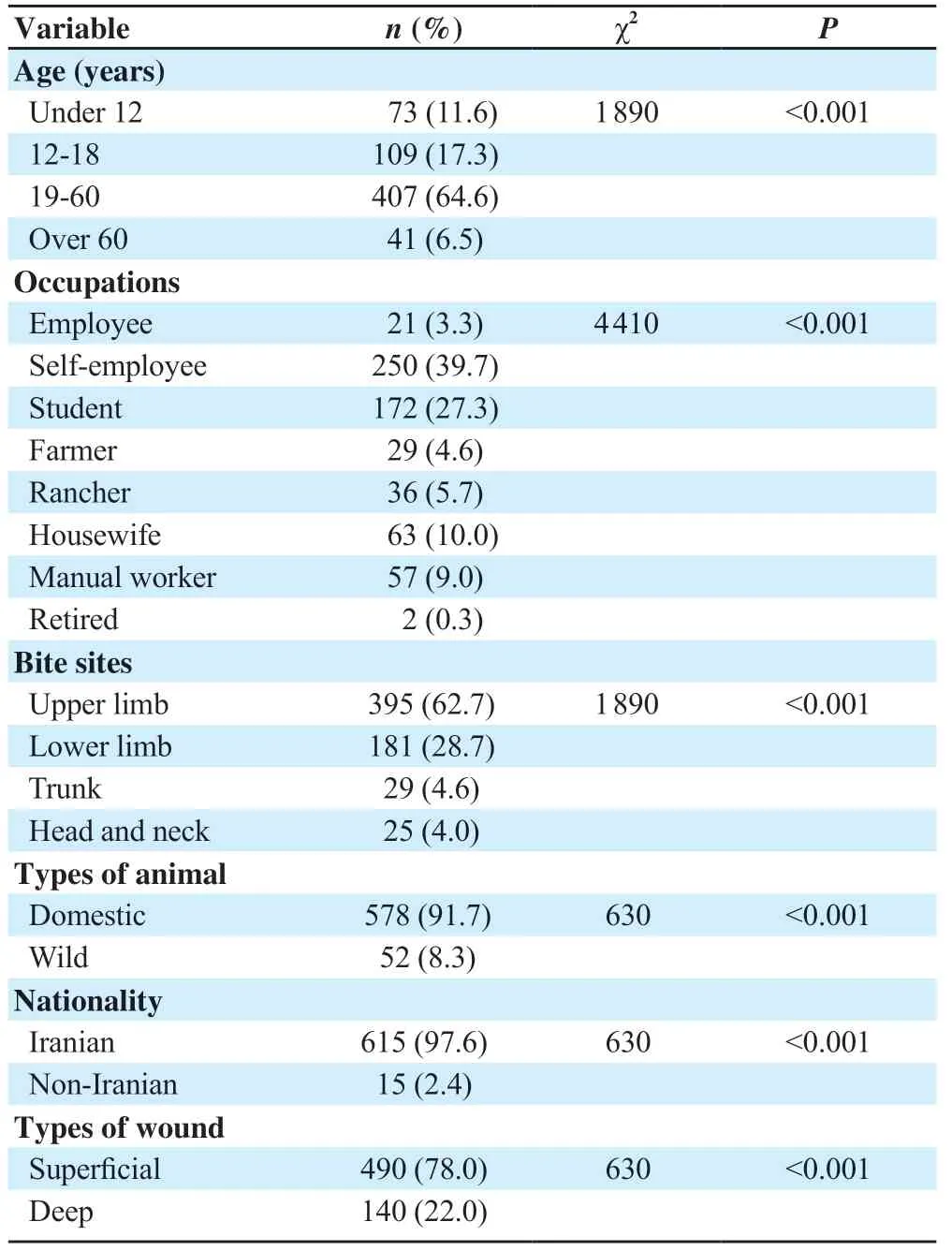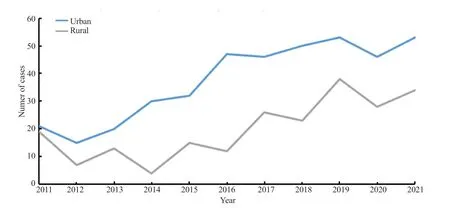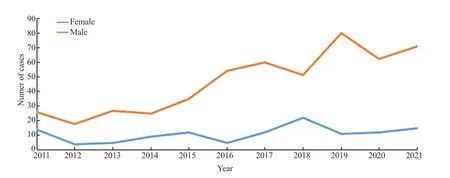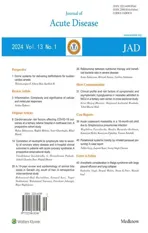A 10-year review and epidemiology of animal bite cases in Gerash city,south of Iran:A retrospective cross-sectional study
2024-03-05MohammadRafiBazrafshanEsmaeilKaviNegarShahkaramiMohammadNowrouziFereidounJahangirHajarHaghshenas
Mohammad-Rafi Bazrafshan ,Esmaeil Kavi,2 ,Negar Shahkarami ,Mohammad Nowrouzi ,Fereidoun Jahangir ,Hajar Haghshenas
1Department of Nursing,School of Nursing,Larestan University of Medical Sciences,Larestan,Iran
2Clinical Education Research Center,Department of Medical Education,School of Medicine,Shiraz University of Medical Sciences,Shiraz,Iran
3School of Allied Medical Sciences,Fasa University of Medical Sciences,Fasa,Iran
4Division of Health Center,Gerash University of Medical Sciences,Gerash,Iran
5Kerman University of Medical Sciences,Kerman,Iran
6Shiraz University of Medical Sciences,Shiraz,Iran
7Department of Nursing,School of Nursing,Gerash University of Medical Sciences,Gerash,Iran
ABSTRACT Objective: To determine the temporal trend and epidemiology of animal bite cases in Gerash City,Iran.Methods: This retrospective cross-sectional study analyzed 630 cases of people with animal bites between 2011 and 2021 in Gerash City.The collected data were analyzed using Chi-square test.Results: The mean age of victims was (30.9±17.5) years.80.54% Of victims were male,39.70% were self-employed,and 64.60% were adults (≥18 years).Most cases of bites occurred in 2019 (91 cases),2020 (74 cases) and 2021 (87 cases),and most of the bites were related to the upper limbs (62.70%).Most of the wounds were superficial (78%),most of the biting animals were domestic animals (91.74%),and most of the victims had Iranian nationality (97.62%).Conclusions: Given the increasing trend of animal bites in Gerash City,health authorities should carry out basic measures such as education and awareness among the public,especially at-risk groups such as adult males.Additionally,since most cases of bites are due to dogs,it seems necessary to plan for vaccination of dogs,especially those with owners.
KEYWORDS: Animal bite;Gerash;Time trend;Disease;Epidemiology;Rabies
Significance
In Iran,animal bites are one of the communicable diseases.A growing number of trends are putting pressure on individual and society as a whole,which has major implications for the economy and health.The results of this study can provide a very good basis for understanding epidemiological trends in the disease and predicting its incidence at health centers and medical universities.
1.Introduction
Animal bites and bite-related diseases are considered serious health and economic problems worldwide[1,2].Animal bites are one of the leading causes of death worldwide[3].According to the Centers for Disease Control and Prevention,approximately 4.7 million people are bitten by animals worldwide each year[4].Studies have shown that 60%-80% of animal bites are from dogs and 20%-30% are from cats[5].
Dogs are the leading cause of human death from rabies.The infection kills tens of thousands of people annually,primarily in Asia and Africa.According to the World Health Organization (2021),rabies costs an estimated $8.6 billion per year[6].It is estimated that rabies annually causes approximately 59 000 human deaths,more than 3.7 million life years with disability,and $8.6 billion in economic losses[7].
Asia bears the greatest burden of rabies.About 60% of all human deaths and years of life lost with disability caused by rabies occur in Asia[7].In Iran,rabies occurs in both wild and domestic animals,and it is still one of the major health and economic problems.Almost all provinces of the country are more or less infected with this disease[8].Rabies is the most common disease of humans and animals in Iran,which causes a significant cost to the public health system after infection[9].Transmission occurs mainly through the bite of domestic dogs[10].
The distribution pattern of animal bites varies in different cities of Iran[11].For example,in Khorramshahr[12] most cases of animal bites occurred among urban residents.However,the results of studies in other cities show that animal bites are more common in rural areas than in urban areas[13-15].In the city of Chaldoran,most bites were observed in males in the age group of 10 to 19 years[14].In Tehran[16] and Quchan[13],most cases of animal bites were reported in people aged 21-30 years.
The growing trend in animal bites[17] and the high incidence in different cities of Iran[14,18-21] show the importance of managing and investigating different aspects of animal bites.Accurate information on the epidemiological status of a disease is necessary for effective prevention programs[9].In this regard,knowledge of the epidemiology of animal bites and the associated risk factors is particularly important.In recent years,many studies have been conducted on the epidemiology of animal bites in different parts of the country[12-14,16,18-21],however,due to the wide geographical area,climatic diversity,and different animal species in each region,as well as differences in population health status and awareness of rabies prevention,separate surveys are needed in different regions of the country.Therefore,due to the lack of accurate data on the epidemiology of animal bites in the city of Gerash,it is necessary to conduct a study for this purpose.This information is one of the most important and indispensable prerequisites for educational planning and preventive measures at the city level.Reducing the frequency of animal bites may lead to a reduction in the risk of contracting rabies and thus reduce health care costs.In this regard,this study was conducted to determine the temporal trend and epidemiology of animal bites in Gerash City between 2011 and 2021.
2.Subjectives and methods
2.1.Subjects
The study includes all individuals with animal bites who were referred to the Center for Disease Control in Gerash,Fars province,southern Iran,from 2011 to 2021.
2.2.Data gathering
Two trained researchers collected the data using a standard form that included items about sex,occupation,place of occurrence,type of biting animal,nationality,location,and severity of wound on the body.The researchers investigated all records of animal bite cases in the Center for Communicable Diseases of Gerash from 2011 to 2021 during daily visits.To minimize missing data,researchers obtained additional information over the phone when some information in patients’ records was incomplete.
2.3.Ethical statement
The current study was approved by the Ethics Committee of Gerash University of Medical Sciences,Gerash,Iran (Approval code:IR.GERUMS.REC.1400.024).
2.4.Statistical methods
The SPSS statistical package version 19 was used.Continuous variables were expressed as mean±SD,while categorical variables were expressed as percentages and analyzed by Chi-square test.A significance level of 0.05 was considered.
3.Results
The average age of bite cases was (30.9 ± 17.5) years.As shown in Table 1,the majority of bite cases occurred in 2019 (91 cases),2020 (74 cases),and 2021 (87 cases).

Table 1.Distribution of bite cases annualy (n=630).
Table 2 indicates that most cases were between 19-60 years old (407 cases),self-employed (250 cases),and Iranian (615 cases).The most bitten part was the upper limbs (395 cases) and superficial wounds (490 cases),and the bites were caused by pets (578 cases).

Table 2.Basic characteristics of animal bites between 2011 and 2021 (n=630).
Animal bites occurred more in urban area (Figure 1) and the incidence was much higher among men than among women (Figure 2).
He grew up, handsome for his misfortune. A favorite with his fellow students, he might have been class president, but for that. He developed a gift, a talent for literature and music.

Figure 1. Location distribution of animal bites between 2011 and 2021.

Figure 2. Sex distribution of case number of animal bites in 2011-2021.
4.Discussion
This study investigated the trend and epidemiology of animal bite cases in Gerash City between 2011 and 2021.During this period,a total of 630 animal bites occurred.The results of the present study indicate that the trend of animal bites has increased in Gerash City.This upward trend may increase people’s knowledge of the complications and consequences of animal bites,as well as their awareness and willingness to visit health centers for supportive care and treatment.97.62% Of the samples had Iranian nationality.The average age of the victims was (30.9±17.5) years.The highest frequency of bites occurred in the age range of 19-60 years (64.60%) followed by the age group of 12-18 years (17.30%).In Khorramshahr and Bardesir,most cases of animal bites were in the adult age group[12,19].However in Borujerd,most cases were in the age group of less than 10 years[15].Patel et al.reported that the largest group of people are under the age of 15[22].In India[23],people between the ages of 15 and 45 were more likely to be attacked by animals.In the study of Babazadeh et al.[14],the majority of bites were observed in men in the age group of 10 to 19 years.In Tehran[16] and Quchan[13],most cases of animal bites were reported among people aged 21-30 years.From these findings,it can be concluded that animal bites can happen to people at any age and the prevalence is not the same in different countries and cities.The adult population of our study may be more exposed to animal bites because they spend more time outside the house for business,recreation,or in general for many economic and social activities.Also,playing with animals and provoking them can be one of the causes of animal bites in this age group.
Consistent with the results of studies conducted in various cities and countries,our study revealed that the number of animal bite cases in men (80.54%) was significantly higher than in women.For instance,in Jahrom[18],Tehran[16],and India[23],79.6%,84.15%,and 76.3% of the injured were men,respectively.This could be attributed to the fact that more men in Gerash city work outside their home,such as in gardens and dates-groves,which increases their exposure to all kinds of animals.Additionally,men tend to engage in more outdoor activities,especially at night,compared to women.
Most of the animal bite cases in our study were self-employed individuals.In Babaeeian-Moghaddam et al.’s study[13],housewives (24%) and students (23%) were the most frequently affected groups.In Alian et al.’s study[18],self-employed individuals (48.6%) and students (13.7%) had the highest incidence rates.Self-employment in Gerash City encompasses a wide range of jobs that may involve working at different times or in high-risk areas,which can increase the likelihood of bites.
Our study found that,most cases of animal bites occurred in urban areas (65.35%).This finding is consistent with the studies of Kasiri et al.In Khorramshahr[12] and Poorolajal et al.in Tehran[16],which reported 83.5% and 66.27% of cases in urban areas,respectively.However,our study’s results were not consistent with studies related to other cities that showed a higher occurrence of bite cases in rural areas[13-15].The higher prevalence of animal bites in urban areas can be attributed to the presence of stray dogs in and around the city,as well as the possibility of more people living in the city visiting health centers.
In terms of the bite area,our study found that the highest number of bites was related to the upper limb (one hand),leg (one leg),and then the face.Upper limb involvement was significantly higher.This finding is consistent with the studies of Zohrevandi et al.[24] and Janatolmakan et al.[17].In Ghannad et al.study[15],the leg (46.6%) and then the hands (41.8%) were the most common bite sites.In Poorolajal et al.’s study[16],the legs (45.62%) and hands (43.36%) were the most bitten places.Kasiri et al.[12] and Marathe et al.[23] also reported that lower limbs were bitten more than other parts of the body.The higher prevalence of bites on the hands and feet can be related to the fact that people usually use their hands or feet to defend themselves against animals.Additionally,the possibility of injury to the upper limbs increases when feeding and caring for animals.
The highest number of animal bites in Gerash City were caused by a dog with urban and then rural owners.After that,most of the cases of being bitten by a dog without an urban owner and a rural owner have happened.Consistent with this study,Li et al.’s research[25],found that the most of cases were bitten by domestic animals such as dogs and cats.In Kenya,the majority of victims were attacked by their dogs[26].Additionally,in the Ghannad et al.[15],and Alian et al.[18],reported the majority of bite cases were caused by dogs and cats,respectively.It seems that the role of domestic animals in the occurrence of animal bites is greater than that of wild animals.The reason can be attributed to the presence of these animals in people’s lives or workplaces (livestock and agricultural jobs),which increases their exposure to being bitten by dogs.
Consistent with the Alian et al.study in Jahrom City[18],our study found the highest frequency of wound depth was significantly related to superficial wounds (78%).
The most important strength of the current study was considering the 10-year trend of animal bite cases and this study limitation was the small sample size.
Considering the upward trend of animal bites in Gerash City,it is recommended to the health authorities to carry out basic measures such as educating and increasing the awareness of the public,especially the groups at risk such as adult men with various economic-social activities,and people who have pets.Since most cases of bites are attributed to dogs,it seems necessary to plan for vaccinating dogs,especially those with owners.Additionally,restraining dogs by their owners to prevent them from attacking people can be effective in reducing animal bite cases.
Conflict of interest statement
The authors report no conflict of interest.
Funding
This study was financially supported by the vice-chancellery for research affairs at Gerash University of Medical Sciences,Gerash,Iran (Grant number:99000071).
Data availability statement
The data supporting the findings of this study are available from the corresponding authors upon request.
Authors’ contributions
All authors participated in the initial writing,revision,presentation,and design of the manuscript,as well as the collection and analysis of data.Furthermore,all authors accept the responsibility for the accuracy and correctness of the contents of the present manuscript and approve the final version of the manuscript.
杂志排行
Journal of Acute Disease的其它文章
- Cardiovascular risk factors affecting COVID-19 outcomes at a tertiary referral hospital in northwest Iran:A prospective cohort study
- Correlation of neutrophil to lymphocyte ratio to severity of coronary artery disease and in-hospital clinical outcomes in patients with acute coronary syndrome:A prospective observational study
- Relationship between nutritional therapy and beneficial bacteria ratio in severe disease
- Clinical profile and risk factors of symptomatic and asymptomatic hypoglycemia in neonates admitted to NICU in a tertiary care center:A cross-sectional study
- Acute coalescent mastoiditis in a 16-month-old child due to Streptococcus pneumoniae infection
- Paradoxical systemic toxicity by inhaled paraquat poisoning:A case report
